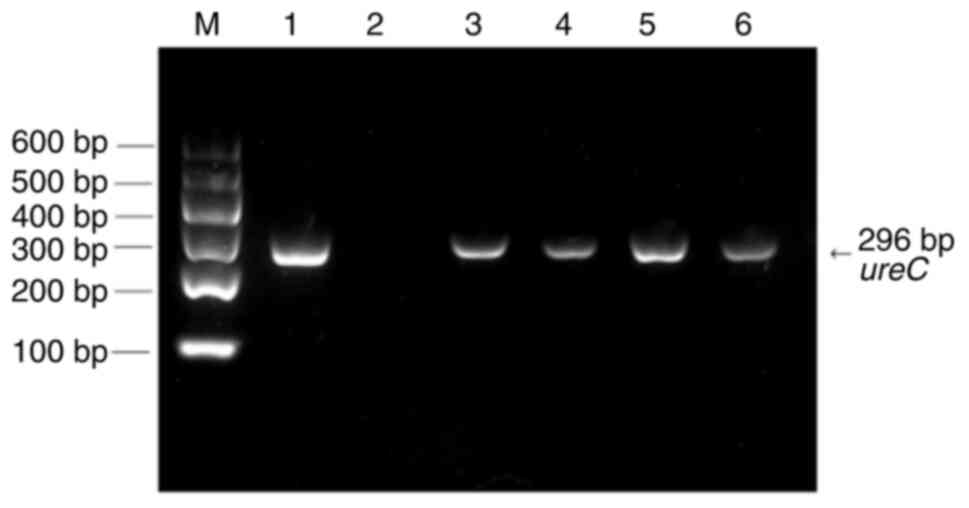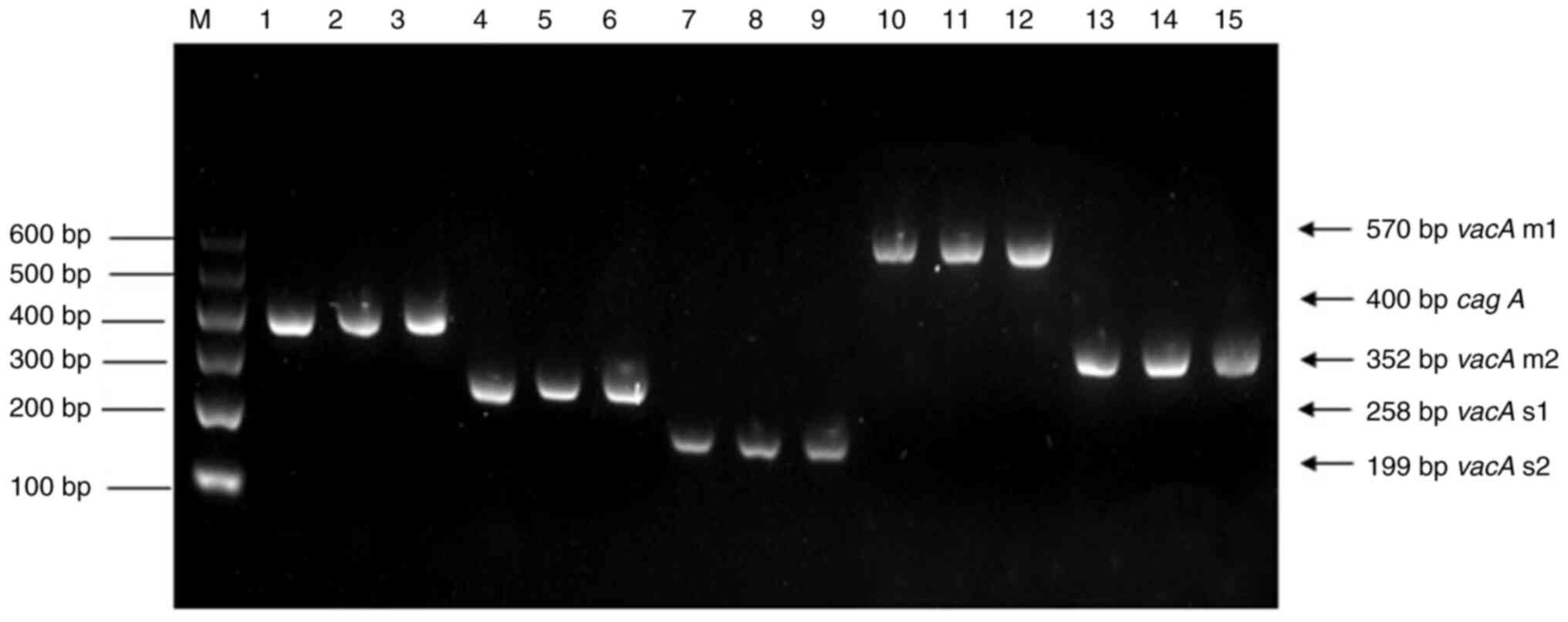|
1
|
Shokrzadeh L, Baghaei K, Yamaoka Y, Dabiri
H, Jafari F, Sahebekhtiari N, Tahami A, Sugimoto M, Zojaji H and
Zali MR: Analysis of 3'-end variable region of the cagA gene
in Helicobacter pylori isolated from Iranian population. J
Gastroenterol Hepatol. 25:172–177. 2010.PubMed/NCBI View Article : Google Scholar
|
|
2
|
Yadegar A, Mobarez AM, Alebouyeh M,
Mirzaei T, Kwok T and Zali MR: Clinical relevance of cagL gene and
virulence genotypes with disease outcomes in a Helicobacter
pylori infected population from Iran. World J Microbiol
Biotechnol. 30:2481–2490. 2014.PubMed/NCBI View Article : Google Scholar
|
|
3
|
Yadegar A, Alebouyeh M and Zali MR:
Analysis of the intactness of Helicobacter pylori cag
pathogenicity island in Iranian strains by a new PCR-based strategy
and its relationship with virulence genotypes and EPIYA motifs.
Infect Genet Evol. 35:19–26. 2015.PubMed/NCBI View Article : Google Scholar
|
|
4
|
Abu-Lubad M, Alzoubi H, Jarajreh D,
Sawalqa AA, Bruggemann H, Albataineh E, Aqel A and Al-Zeer M:
Analysis of Helicobacter pylori genotypes amongst Jordanians'
dental plaque samples. Gastroenterology Res. 11:46–51.
2018.PubMed/NCBI View Article : Google Scholar
|
|
5
|
Handa O, Naito Y and Yoshikawa T: Redox
biology and gastric carcinogenesis: The role of Helicobacter
pylori. Redox Rep. 16:1–7. 2011.PubMed/NCBI View Article : Google Scholar
|
|
6
|
Zaric S, Bojic B, Popovic B and Milasin J:
Eradication of gastric Helicobacter pylori ameliorates
halitosis and tongue coating. J Contemp Dent Pract. 16:205–209.
2015.PubMed/NCBI View Article : Google Scholar
|
|
7
|
El Batawi HY, Venkatachalam T, Francis A,
Abujabal R and Shehadat SA: Dental caries-A hiding niche for
Helicobacter pylori in Children. J Clin Pediatr Dent.
44:90–94. 2020.PubMed/NCBI View Article : Google Scholar
|
|
8
|
Ding YJ, Yan TL, Hu XL, Liu JH, Yu CH, Li
YM and Wang QY: Association of salivary Helicobacter pylori
infection with oral diseases: A cross-sectional study in a Chinese
population. Int J Med Sci. 12:742–747. 2015.PubMed/NCBI View Article : Google Scholar
|
|
9
|
Jalili M, Mahmoodabadi KA and Sayehmiri K:
Relationship between Helicobacter pylori and periodontal
diseases: A metaanalysis study and systematic review. Open Dent J.
14:362–368. 2020.
|
|
10
|
Adachi K, Notsu T, Mishiro T, Yoshikawa H
and Kinoshita Y: Influence of Helicobacter pylori infection
on periodontitis. J Gastroenterol Hepatol. 34:120–123.
2019.PubMed/NCBI View Article : Google Scholar
|
|
11
|
Pihlstrom BL, Michalowicz BS and Johnson
NW: Periodontal diseases. Lancet. 366:1809–1820. 2005.PubMed/NCBI View Article : Google Scholar
|
|
12
|
Krajden S, Fuksa M, Anderson J, Kempston
J, Boccia A, Petrea C, Babida C, Karmali M and Penner JL:
Examination of human stomach biopsies, saliva, and dental plaque
for Campylobacter pylori. J Clin Microbiol. 27:1397–1398.
1989.PubMed/NCBI View Article : Google Scholar
|
|
13
|
Ferguson DA Jr, Li C, Patel NR, Mayberry
WR, Chi DS and Thomas E: Isolation of Helicobacter pylori
from saliva. J Clin Microbiol. 31:2802–2804. 1993.PubMed/NCBI View Article : Google Scholar
|
|
14
|
Anand PS, Kamath KP and Anil S: Role of
dental plaque, saliva and periodontal disease in Helicobacter
pylori infection. World J Gastroenterol. 20:5639–5653.
2014.PubMed/NCBI View Article : Google Scholar
|
|
15
|
Silva DG, Stevens RH, Macedo JM, Albano
RM, Falabella ME, Fischer RG, Veerman EC and Tinoco EM: Presence of
Helicobacter pylori in supragingival dental plaque of
individuals with periodontal disease and upper gastric diseases.
Arch Oral Biol. 55:896–901. 2010.PubMed/NCBI View Article : Google Scholar
|
|
16
|
Salehi MR, Shah AM, Naghsh N, Hajisadeghi
S and Ajami EA: Comparison in prevalence of Helicobacter
pylori in the gingival crevicular fluid from subjects with
periodontitis and healthy individuals using polymerase Chain
reaction. J Dent Res Dent Clin Dent Prospects. 7:238–243.
2013.PubMed/NCBI View Article : Google Scholar
|
|
17
|
Al-Ahmad A, Kürschner A, Weckesser S,
Wittmer A, Rauberger H, Jakob T, Hellwig E, Kist M and Waidner B:
Is Helicobacter pylori resident or transient in the human
oral cavity? J Med Microbiol. 61:1146–1152. 2012.PubMed/NCBI View Article : Google Scholar
|
|
18
|
Backert S and Tegtmeyer N: The versatility
of the Helicobacter pylori vacuolating cytotoxin vacA
in signal transduction and molecular crosstalk. Toxins (Basel).
2:69–92. 2010.PubMed/NCBI View Article : Google Scholar
|
|
19
|
Shiota S, Suzuki R and Yamaoka Y: The
significance of virulence factors in Helicobacter pylori. J
Dig Dis. 14:341–349. 2013.PubMed/NCBI View Article : Google Scholar
|
|
20
|
Reyes-Leon A, Atherton JC, Argent RH,
Puente JL and Torres J: Heterogeneity in the activity of Mexican
Helicobacter pylori strains in gastric epithelial cells and
its association with diversity in the cagA gene. Infect
Immun. 75:3445–3454. 2007.PubMed/NCBI View Article : Google Scholar
|
|
21
|
Rudi J, Rudy A, Maiwald M, Kuck D, Sieg A
and Stremmel W: Direct determination of Helicobacter pylori
vacA genotypes and cagA gene in gastric biopsies and
relationship to gastrointestinal diseases. Am J Gastroenterol.
94:1525–1531. 1999.PubMed/NCBI View Article : Google Scholar
|
|
22
|
Martínez-Carrillo DN, Garza-González E,
Betancourt-Linares R, Mónico-Manzano T, Antúnez-Rivera C,
Román-Román A, Flores-Alfaro E, Illades-Aguiar B and
Fernández-Tilapa G: Association of IL1B-511C/-31T haplotype and
Helicobacter pylori vacA genotypes with gastric ulcer and
chronic gastritis. BMC Gastroenterol. 10(126)2010.PubMed/NCBI View Article : Google Scholar
|
|
23
|
Wongphutorn P, Chomvarin C, Sripa B,
Namwat W and Faksri K: Detection and genotyping of Helicobacter
pylori in saliva versus stool samples from asymptomatic
individuals in Northeastern Thailand reveals intra-host
tissue-specific H. pylori subtypes. BMC Microbiol.
18(10)2018.PubMed/NCBI View Article : Google Scholar
|
|
24
|
Papapanou PN, Sanz M, Buduneli N, Dietrich
T, Feres M, Fine DH, Flemmig TF, Garcia R, Giannobile WV, Graziani
F, et al: Periodontitis: Consensus report of workgroup 2 of the
2017 world workshop on the classification of periodontal and
peri-implant diseases and conditions. J Periodontol. 89 (Suppl
1):S173–S182. 2018.PubMed/NCBI View Article : Google Scholar
|
|
25
|
Tonetti MS, Greenwell H and Kornman KS:
Staging and grading of periodontitis: Framework and proposal of a
new classification and case definition. J Periodontol. 89 (Suppl
1):S159–S172. 2018.PubMed/NCBI View Article : Google Scholar
|
|
26
|
Montero E, Herrera D, Sanz M, Dhir S, Van
Dyke T and Sima C: Development and validation of a predictive model
for periodontitis using NHANES 2011-2012 data. J Clin Periodontol.
46:420–429. 2019.PubMed/NCBI View Article : Google Scholar
|
|
27
|
Palmer R and Floyd P (eds): BDJ
clinician's guides. London: Springer Nature Switzerland AG, pp1-15,
2021.
|
|
28
|
Momtaz H, Souod N, Dabiri H and Sarshar M:
Study of Helicobacter pylori genotype status in saliva,
dental plaques, stool and gastric biopsy samples. World J
Gastroenterol. 18:2105–2111. 2012.PubMed/NCBI View Article : Google Scholar
|
|
29
|
Valadan Tahbaz S, Yadegar A, Amirmozafari
N, Yaghoobee S, Ehsani Ardakani MJ and Zojaji H: Occurrence of
Helicobacter pylori and its major virulence genotypes in
dental plaque samples of patients with chronic periodontitis in
Iran. Gastroenterol Hepatol Bed Bench. 10 (Suppl 1):S70–S78.
2017.PubMed/NCBI
|
|
30
|
Yamaoka Y, Kodama T, Gutierrez O, Kim JG,
Kashima K and Graham DY: Relationship between Helicobacter
pylori iceA, cagA, and vacA status and clinical
outcome: Studies in four different countries. J Clin Microbiol.
37:2274–2279. 1999.PubMed/NCBI View Article : Google Scholar
|
|
31
|
Ito Y, Azuma T, Ito S, Miyaji H, Hirai M,
Yamazaki Y, Sato F, Kato T, Kohli Y and Kuriyama M: Analysis and
typing of the vacA gene from cagA positive strains of
Helicobacter pylori isolated in Japan. J Clin Microbiol.
35:1710–1714. 1997.PubMed/NCBI View Article : Google Scholar
|
|
32
|
De Gusmão VR, Nogueira Mendes E, De
Magalhães Queiroz DM, Aguiar Rocha G, Camargos Rocha AM, Ramadan
Ashour AA and Teles Carvalho AS: vacA genotypes in
Helicobacter pylori strains isolated from children with and
without duodenal ulcer in Brazil. J Clin Microbiol. 38:2853–2857.
2000.PubMed/NCBI View Article : Google Scholar
|
|
33
|
Zheng P and Zhou W: Relation between
periodontitis and Helicobacter pylori infection. Int J Clin
Exp Med. 8:16741–16744. 2015.PubMed/NCBI
|
|
34
|
Eskandari A, Mahmoudpour A, Abolfazli N
and Lafzi A: Detection of Helicobacter pylori using PCR in
dental plaque of patients with and without gastritis. Med Oral
Patol Oral Cir Bucal. 15:e28–e31. 2010.PubMed/NCBI View Article : Google Scholar
|
|
35
|
Yee JKC: Are the view of Helicobacter
pylori colonized in the oral cavity an illusion? Exp Mol Med.
49(e397)2017.PubMed/NCBI View Article : Google Scholar
|
|
36
|
Bektas M, Soykan I, Altan M, Alkan M and
Ozden A: The effect of Helicobacter pylori eradication on
dyspeptic symptoms, acid reflux and quality of life in patients
with functional dyspepsia. Eur J Intern Med. 20:419–423.
2009.PubMed/NCBI View Article : Google Scholar
|
|
37
|
Wang XM, Yee KC, Hazeki-Taylor N, Li J, Fu
HY, Huang ML and Zhang GY: Oral Helicobacter pylori, its
relationship to successful eradication of gastric H. pylori
and saliva culture confirmation. J Physiol Pharmacol. 65:559–566.
2014.PubMed/NCBI
|
|
38
|
Aksit Bıcak D, Akyuz S, Kıratlı B, Usta M,
Urganci N, Alev B, Yarat A and Sahin F: The investigation of
Helicobacter pylori in the dental biofilm and saliva samples
of children with dyspeptic complaints. BMC Oral Health.
17(67)2017.PubMed/NCBI View Article : Google Scholar
|
|
39
|
Falsafi T, Khani A, Mahjoub F, Asgarani E
and Sotoudeh N: Analysis of vacA/cagA
genotypes/status in Helicobacter pylori isolates from
Iranian children and their association with clinical outcome. Turk
J Med Sci. 45:170–177. 2015.PubMed/NCBI View Article : Google Scholar
|
|
40
|
Miehlke S, Kirsch C, Agha-Amiri K, Günther
T, Lehn N, Malfertheiner P, Stolte M, Ehninger G and Bayerdörffer
E: The Helicobacter pylori vacA s1, m1 genotype and
cagA is associated with gastric carcinoma in Germany. Int J
Cancer. 87:322–327. 2000.PubMed/NCBI
|
|
41
|
Hu B, Zhao F, Wang S, Xiang P, Yang C,
Fang Y, Chen F, Yang F, Zhao H and Zhang Y: Correlation of
Helicobacter pylori virulence genotypes and clinical
characteristics. Lab Med. 31:479–485. 2016.
|
|
42
|
Link A, Langner C, Schirrmeister W,
Habendorf W, Weigt J, Venerito M, Tammer I, Schlüter D, Schlaermann
P, Meyer TF, et al: Helicobacter pylori vacA genotype is a
predominant determinant of immune response to Helicobacter
pylori CagA. World J Gastroenterol. 23:4712–4723.
2017.PubMed/NCBI View Article : Google Scholar
|
|
43
|
Homan M, Luzar B, Kocjan BJ, Orel R,
Mocilnik T, Shrestha M, Kveder M and Poljak M: Prevalence and
clinical relevance of cagA, vacA, and iceA genotypes
of Helicobacter pylori isolated from Slovenian children. J
Pediatr Gastroenterol Nutr. 49:289–296. 2009.PubMed/NCBI View Article : Google Scholar
|
|
44
|
Ferreira RM, Pinto-Ribeiro I, Wen X,
Marcos-Pinto R, Dinis-Ribeiro M, Carneiro F and Figueiredo C:
Helicobacter pylori cagA promoter region sequences influence
CagA expression and interleukin 8 secretion. J Infect Dis.
213:669–673. 2016.PubMed/NCBI View Article : Google Scholar
|
|
45
|
Mendoza-Cantú A, Urrutia-Baca VH,
Urbina-Ríos CS, De la Garza-Ramos MA, García-Martínez ME and
Torre-Martínez HHH: Prevalence of Helicobacter pylori vacA
genotypes and cagA gene in dental plaque of asymptomatic
Mexican children. Biomed Res Int. 2017(4923640)2017.PubMed/NCBI View Article : Google Scholar
|
|
46
|
Lukeš P, Pavlík E, Potuznikova B, Nartova
E, Foltynova E, Plzak J, Katra R, Sterzl I, Bartunkova J, Betka J
and Astl J: Detection of Helicobacter pylori in
oropharyngeal lymphatic tissue with real-time PCR and assessment of
its carcinogenic potential. Eur Arch Otorhinolaryngol. 271:399–405.
2014.PubMed/NCBI View Article : Google Scholar
|
















